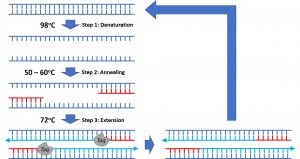This post has been edited to conform to assignment formatting.
The original documents will be available for download below for integrity reasons.
Originally posted on: Oct 7, 2020 at 09:38
Hi team,
Please find my revised definition assignment on PCR below. The assignment has been edited to reflect the feedback graciously provided by Jen Deluz.
Best,
Jonathan Ho
Original Documents:
Revised assignment: 301 Jonathan Ho Revised Three Definitions
Original assignment: 301 Jonathan Ho Three Definitions
Peer Review by Jen Deluz: 301 Jen Deluz Three Definitions Peer Review
Assignment 1.3 – Revised Three Definitions
Introduction: Explaining technical terms to a non-technical audience is a common occurrence, often requiring definitions. This assignment aims to highlight the importance and role of definitions in technical writing. The following term will be defined at three levels of detail to accommodate for different situations.
Technical Term: Polymerase Chain Reaction
Scenario: A biologist explaining Polymerase Chain Reaction to a person with little to no knowledge of science and biology. Assumes the person has heard of DNA (unique genetic material in every organism) but does not know what it is in detail.
Parenthetical Definition: Polymerase Chain Reaction (technique for copying DNA) is the foundation for many other complex biological techniques and applications.
Sentence Definition: Polymerase Chain Reaction is a biological technique that is used to make many copies of a small section of DNA.
Expanded Definition: The term Polymerase Chain Reaction is most well-known in its acronym form, PCR. Like its name suggests, PCR describes a continuous cycle of reactions involving a special molecule called polymerase.
PCR is a reaction, meaning there are inputs and outputs. The output is known to be many copies of DNA; the inputs are described as follows and are also shown in figure 1 below.
- DNA template – the sample containing the section of DNA to be copied.
- Polymerase – a special molecule that can build DNA.
- Nucleotides – can be thought of as “building blocks” that polymerase puts together to build the DNA.
- Primers – short pieces of one-sided DNA that attach to the DNA template and show where the polymerase should start the copying process.

Figure 1. Components of PCR. DNA is the DNA template. Polymerase is not shown here but will be in a later figure. Image adapted from source: https://www.clinisciences.com/en/buy/cat-conventional-pcr-3473.html
Once all the inputs have been mixed, there are three steps that occur (see figure 2 below).
- Denaturation – under high temperature the DNA template splits into two separate strands.
- Annealing – primers (short one-sided pieces of DNA) attach to the single stranded DNA at a slightly cooler 50-60 degrees Celsius.
- Extension – polymerase attaches to the primers and uses the nucleotides (building blocks) to make a copy of the DNA.
These three steps produce two identical copies of the original DNA sample. The reaction can then be repeated or chained together many times to make millions of copies.

Figure 2. Simplified overview of PCR. Short red pieces in Step 2 are the primers. Taq is a type of polymerase. Light blue segments in Step 3 show how Taq polymerase would build the DNA copy using the nucleotides. Source: https://toptipbio.com/polymerase-chain-reaction-pcr/
As previously mentioned, PCR is the foundation for many other biological techniques and applications. One such application is forensic analysis. There are certain sections of DNA that are unique to each person, so even if only trace amounts of DNA are found, they can be copied many times allowing scientists to investigate and determine the person of interest. Another use of PCR is infectious disease detection. Because bacteria and viruses also have unique genetic material, PCR can detect bacterial and viral infections even if the traces are incredibly small.
Works Cited:
Bradburn, S., & PhD. (2017, November 22). What Is The Polymerase Chain Reaction (PCR)? Top Tip Bio. https://toptipbio.com/polymerase-chain-reaction-pcr/
Conventional PCR Clinisciences. (n.d.). Retrieved October 6, 2020, from https://www.clinisciences.com/en/buy/cat-conventional-pcr-3473.html
Polymerase Chain Reaction (PCR). (n.d.). Retrieved September 28, 2020, from https://www.ncbi.nlm.nih.gov/probe/docs/techpcr/
Polymerase Chain Reaction (PCR) Fact Sheet. (n.d.). Genome.Gov. Retrieved September 28, 2020, from https://www.genome.gov/about-genomics/fact-sheets/Polymerase-Chain-Reaction-Fact-Sheet
Ruano, G., Pagliaro, E. M., Schwartz, T. R., Lamy, K., Messina, D., Gaensslen, R. E., & Lee, H. C. (1992). Heat-soaked PCR: An efficient method for DNA amplification with applications to forensic analysis. BioTechniques, 13(2), 266–274.
Tiner, S. (n.d.). The Science Behind the Test for the COVID-19 VirusDiscovery’s Edge. Https://Discoverysedge.Mayo.Edu/. Retrieved September 28, 2020, from https://discoverysedge.mayo.edu/2020/03/27/the-science-behind-the-test-for-the-covid-19-virus/
Leave a Reply